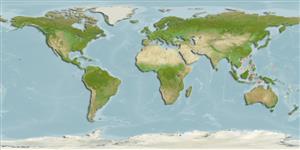Elasmobranchii (tubarões e raias) (sharks and rays) >
Carcharhiniformes (Ground sharks) >
Scyliorhinidae (Cat sharks) > Scyliorhininae
Etymology: Cephaloscyllium: cephalus, from kephale (Gr.), head, referring to its very broad and depressed head; skylion, Greek for dogfish or small shark (See ETYFish); cooki: In honor of the late Sidney F. Cook (1953-1997), shark fisheries biologist, “whose energy, dedication and contribution to shark conservation is sadly missed” (See ETYFish).
Eponymy: Sidney ‘Sid’ F Cook (1953–1997) was a shark fishery conservationist and biologist. [...] (Ref. 128868), visit book page.
More on authors: Last, Séret & White.
Environment: milieu / climate zone / depth range / distribution range
Ecologia
marinhas bentopelágico; intervalo de profundidade 223 - 300 m (Ref. 76946). Tropical
Western Pacific: Australia and Indonesia.
Tamanho / Peso / Idade
Maturity: Lm ? range ? - ? cm
Max length : 29.5 cm TL macho/indeterminado; (Ref. 76946)
Descrição suscinta
Chaves de identificação | Morfologia | Morfometria
This small species has the following set of characters: relatively robust body, head height 10.5-14.2% TL, trunk width 17.1-21.7% TL; origin of first dorsal-fin over the centre or posterior half of pelvic-fin base; prenarial 4.9-5.5% TL in length; preorbital snout length 1.3-1.6 times the prenarial length, 2.5-3.1 in prepectoral length, 5.5-6.6 in prepelvic length; snout-vent length is short, 45.4-49.3% TL; wide nostrils, the width 3.0-3.4% TL; eye-spiracle space wide, 1.0-1.2% TL; small pectoral fin, height 9.4-10.2% TL, posterior margin 8.9-9.8% TL; anal fin low 2.8-3.4% TL; caudal peduncle long, anal-caudal space 6.3-6.9% TL; teeth mainly with 3 cusps near symphysis of upper jaw; mainly weakly tricuspidate are the flank denticles; back without greatly enlarged denticles; very long adult clasper, its outer length to at least 10% TL, almost reaching anal fin, interspace 0.9-1.0% TL; vertebral centra 101-106; tooth count low, 48-62 teeth in each jaw; 8 dark, white-edged saddles on the upper half of body, tail and caudal fin; under-surface mainly uniform greyish, with the snout darkest (Ref. 76946).
Ciclo de vida ou comportamento de acasalamento
Maturidade | Reprodução | Desova | Ovos | Fecundidade | Larvas
Last, P.R., B. Séret and W.T. White, 2008. New swellsharks (Cephaloscyllium: Scyliorhinidae) from the Indo-Australian region. In Last, P.R., White, W.T. & Pogonoski, J.J. (eds.): Descriptions of New Australian Chondrichthyans. CSIRO Marine and Atmospheric Research Paper no. 22. (Ref. 76946)
Status na Lista Vermelha da UICN (Ref. 130435: Version 2024-2)
Ameaça para os humanos
Harmless
Uso pelos humanos
Ferramentas
Relatórios especiais
Baixar XML
Fontes da internet
Estimates based on models
Preferred temperature (Ref.
123201): 8.4 - 13.9, mean 13 °C (based on 28 cells).
Índice de diversidade filogenética (Ref.
82804): PD
50 = 0.5000 [Uniqueness, from 0.5 = low to 2.0 = high].
Bayesian length-weight: a=0.00263 (0.00138 - 0.00502), b=3.21 (3.04 - 3.38), in cm total length, based on LWR estimates for this (Sub)family-body shape (Ref.
93245).
Nível Trófico (Ref.
69278): 3.8 ±0.5 se; based on size and trophs of closest relatives
Resiliência (Ref.
120179): Baixo, tempo mínimo de duplicação da população 4,5 - 14 anos (Preliminary low fecundity).
Fishing Vulnerability (Ref.
59153): Low vulnerability (20 of 100).
